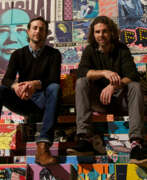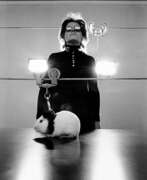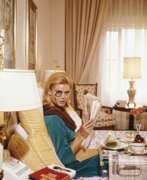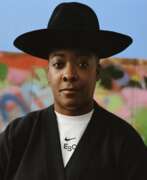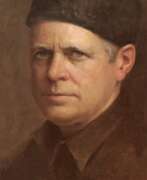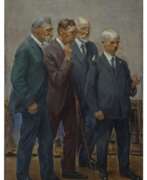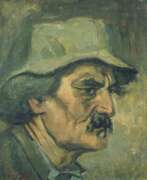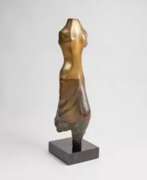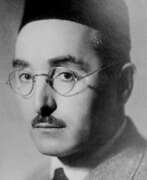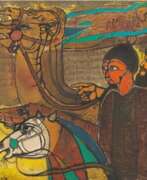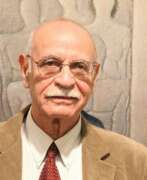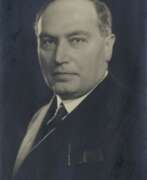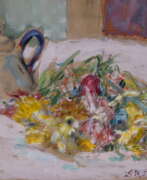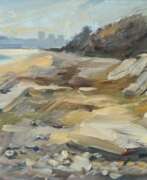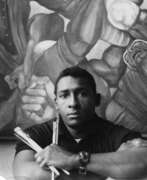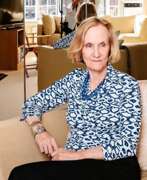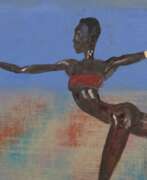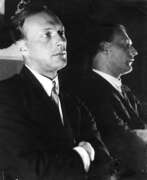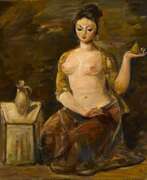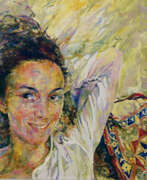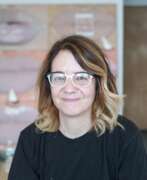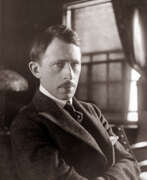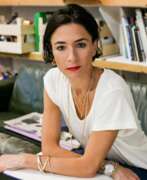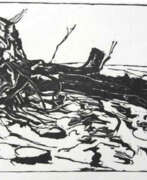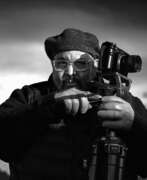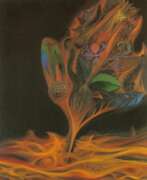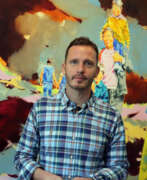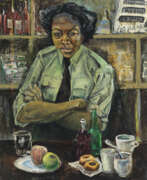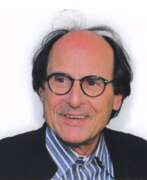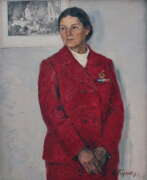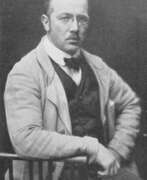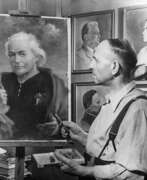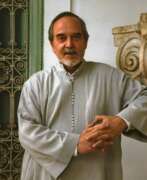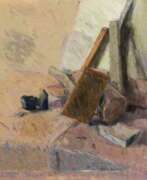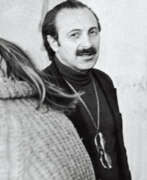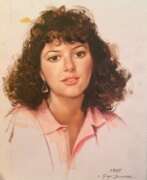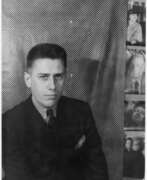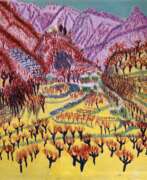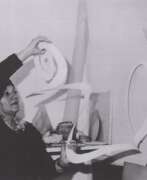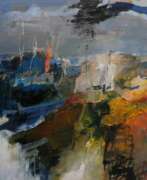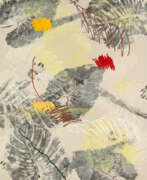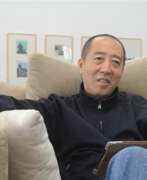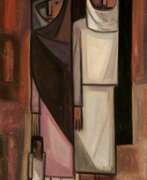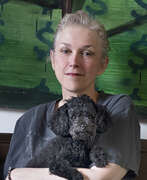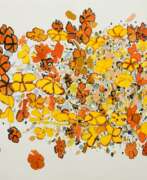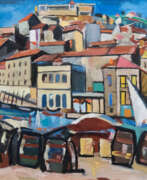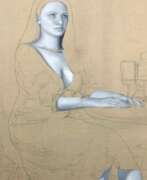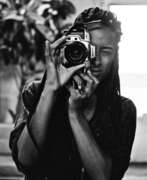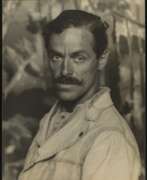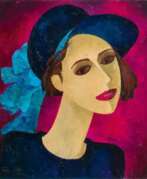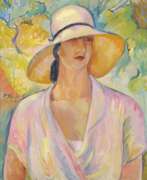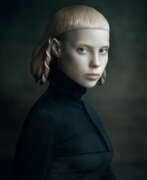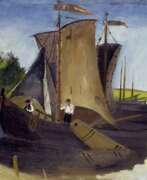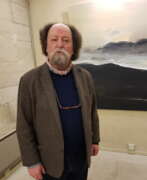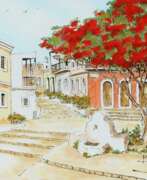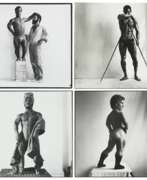Portraitist Contemporary art
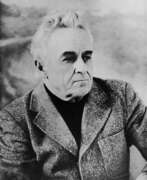

Alexander Grigorievich Maksymenko (Russian: Александр Григорьевич Максименко) was a Soviet and Ukrainian painter of the second half of the twentieth and early twenty-first centuries. He is known as a painter, graphic artist, watercolorist, and art historian.
Alexander Maksymenko worked in the genres of still life, landscape, portrait, as well as in genre painting. His genre works cover themes of collective farm life, including "Masters of the Land" and "Innovators of Collective Farm Fields". For the latter work he received the Stalin Prize. The master actively participated in exhibitions in Ukraine and abroad. His works are in the National Art Museum of Ukraine, the Museum of the History of Ukraine in World War II, as well as in other art museums and private collections.


Herbert Ritts Jr. was an American fashion photographer and director known for his photographs of celebrities, models, and other cultural figures throughout the 1980s and 1990s. His work concentrated on black and white photography and portraits, often in the style of classical Greek sculpture, which emphasized the human shape.
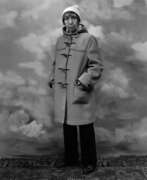

Berenice Alice Abbott was an American photographer best known for her portraits of between-the-wars 20th century cultural figures, New York City photographs of architecture and urban design of the 1930s, and science interpretation in the 1940s to 1960s.
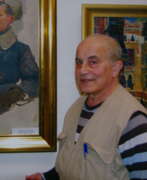

Victor Ashotovich Abramyan (Russian: Виктор Ашотович Абрамян) was a Soviet and Russian artist of the second half of the twentieth and early twenty-first centuries. He is known as a painter, a representative of the Leningrad school.
Victor Abramyan created portraits, landscapes, still lifes and genre paintings. He participated in exhibitions from the early 1970s in Leningrad. Among his famous works are "Blockade everyday life", "Still Life with a Centennial", "Leningrad. 1942. Women on Guard in the besieged city", "Young Guests" and others.
Abramyan's works are in museums and private collections in Russia and many other countries.
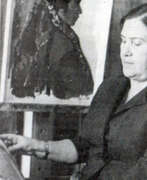

Yevgeniya Mikhailovna Adamova (Russian: Евгения Михайловна Адамова) was a Soviet artist of the second half of the twentieth century. She is known as a painter, People's Artist of the Turkmen SSR.
Yevgeniya Adamova, who moved to Turkmenistan from Ukraine in her youth, was educated at the Ashgabat Art School. During the Great Patriotic War, she creatively expressed herself as a poster artist in the TurkmenTAG agency. The artist created thematic paintings dedicated to the life of the Turkmen people and portraits. She held the post of deputy chairman of the Union of Artists of Turkmenistan.
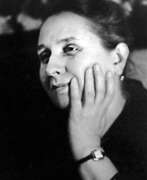

Taisia Kirillovna Afonina (Russian: Таисия Кирилловна Афонина) was a Soviet artist of the second half of the twentieth century. She is known as a painter, graphic artist, representative of the Leningrad school.
Taisia Afonina participated in exhibitions since 1940, creating portraits, landscapes, genre compositions, still lifes and etudes. At the beginning of her career she was interested in military subjects, and then delved into the genre of portraiture and lyrical landscape. Her style is characterized by tonal painting, the rendering of light and air environments and subtle coloristic combinations. In the 1980s she preferred the watercolor technique, painting flowers such as roses, daisies and tulips. Her works are in museums and private collections in Russia and other countries.
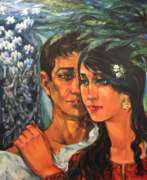

Tamam Al-Akhal is a Palestinian artist and educator living in Jordan. She studied at the Fine Arts College in Cairo. From 1957 to 1960, she taught art at the Makassed Girls College in Beirut. In 1959, she married Ismail Shammout. Al-Akhal has exhibited in Egypt, Lebanon, Jerusalem, Jordan, the United States, Kuwait, England, China, Morocco, Berlin, Paris, Rome, and Vienna. She gave a series of lectures at the Jordan National Gallery of Fine Arts in 2009. Her art appeared on more than a dozen covers of Palestinian Affairs, a magazine published by the Palestine Liberation Organization. She was also head of the PLO's Arts and Heritage section. With her husband, she painted a series of large murals known as "Palestine: The Exodus and the Odyssey."
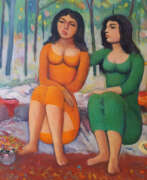

Ismail Al-Sheikhly is a contemporary Iraqui artist. He belonged to one of the first art groups to appear in Iraq, 'La Societe Primitive', founded in 1950. The group later changed its name to 'The Pioneers' and kept it into the 1970s. Some of his works are influenced by Cubism, a movement which grew in popularity throughout the 1950s, and was the preferred artistic style of one of Al-Sheikhly's important contemporaries, Hafiz Drubi. Al Sheikhly’s early works are inspired by the Iraqi village life, though his later works are more focused on abstracted colour combinations and obscured backgrounds. Women feature highly as a central theme in his work. Painted in groups quite often, Al Sheikhly’s women are streamlined with oval faces and generic bodies and seem to always be in states of coming and going, whether that be to the mosque, to the souks, or to do some domestic task.
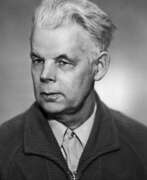

Pyotr Filippovich Alberti (Russian: Пётр Филиппович Альберти) was a Soviet and Russian artist of the second half of the twentieth century. He is known as a painter, a representative of the Leningrad school.
Pyotr Alberti created portraits, landscapes, genre paintings. He actively exhibited since 1951 in Leningrad, demonstrating his works along with the masters of his time. The artist had a broad writing and bright coloring, expressive stroke and used various techniques. He paid special attention to the study of nature. In the late period of his career, he became fond of still life paintings with favorite motifs such as peonies and watermelons.
Alberti's works are preserved in museums and collections around the world.
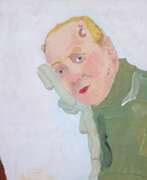

Richard Aldrich is a Brooklyn-based contemporary American conceptual artist and painter who exhibited in the 2010 Whitney Biennial. Aldrich received his BFA degree from the Ohio State University in 1998. Although mostly abstract and casual, Aldrich's paintings also betray a distinctly literary sensibility, even as he targets what he has called the essential "unwordliness of experience." He addresses his own personal history and the way that humans organize information through the formal language of painting, freely citing various aesthetic tropes with humor and irreverence. Aldrich is best known for his loose, abstract compositions, moving freely from gestural mark-making, text-based printing, and cutting the canvas to reveal stretcher bars underneath.
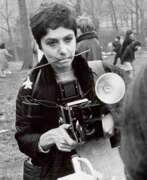

Diane Arbus was an American photographer. Arbus's imagery helped to normalize marginalized groups and highlight the importance of proper representation of all people. She photographed a wide range of subjects including strippers, carnival performers, nudists, people with dwarfism, children, mothers, couples, elderly people, and middle-class families.
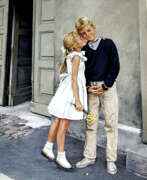

Kurt Ard was a Danish illustrator, painter and printmaker. He became internationally famous for his narrative cover artwork published in popular magazines of the 1950s-1970s, including the Family Journal, the Saturday Evening Post and Reader’s Digest. Ard started his career at various smaller newspapers and worked in the same realistic tradition as his role model, illustrator and painter, Norman Rockwell. During WW II, Kurt struggled to fulfill commission orders. His painting and his reputation and success grew steadily in the post war years. His illustrations soon appeared in major European publications, and he subsequently achieved international fame. Over the course of his career, Ard has sold more than 1000 illustrations to the best magazines in Europe, and to American publications such as McCalls, Good Housekeeping and Redbook. Today, Kurt continues to create exceptional figurative, landscape and seascape paintings with uncompromising authenticity , capturing the charm, beauty and power of these diverse subjects. His work is especially notable for its brilliant light and precise detail.
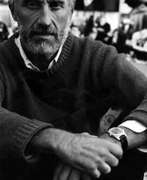

Ugo Attardi was an Italian painter, sculptor and writer. Attardi moved from Genoa to Rome in the early 1950s, where he formed the group Forma 1 together with other artists. His sculpture of Ulysses is now permanently installed in Battery Park in New York
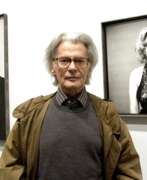

Richard Avedon was an American photographer and artist known for his iconic portraits and fashion photography.
Avedon began his career as a photographer in the late 1940s, working as a freelance photographer for magazines such as Harper's Bazaar and Vogue. He soon became known for his distinctive style, which was characterized by his use of simple, uncluttered backgrounds and his ability to capture the essence of his subjects.
Throughout his career, Avedon photographed some of the most famous people of his time, including Marilyn Monroe, Andy Warhol, and The Beatles. He was also known for his fashion photography, and his work appeared in many fashion magazines, including Harper's Bazaar and Vogue.
Avedon's work was often controversial, as he challenged traditional notions of beauty and fashion. He was known for his willingness to push boundaries, and his work was often seen as a reflection of the social and political issues of his time.
Today, Avedon is regarded as one of the most important photographers of the 20th century, and his work continues to inspire artists and photographers around the world.
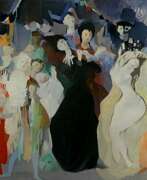

Karl Otto Bachmann, a Swiss painter, graphic artist, and illustrator, began his artistic career in Luzern before moving to Zurich and pursuing freelance work. He achieved a breakthrough in 1943 with the publication of his "Faust" portfolio. Bachmann drew inspiration from his travels across Europe, often joining circus troupes for income and creative ideas. His paintings were characterized by imaginative and virtual settings, with themes revolving around the stage, carnival, and circus. Bachmann's elegant lines, delicate colors, and harmonious compositions made him a respected book illustrator. He actively participated in numerous exhibitions throughout his life, both domestically and internationally.
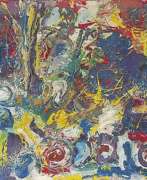

Ernst Rudolf Baerwind was a German painter. Baerwind studied at the art academies in Munich, Berlin and Paris. Baerwind's work was initially based on early German Expressionism. After a surrealist phase, he was influenced in Paris by the painting of the École de Paris and by Informel and then found his way to the International Style.
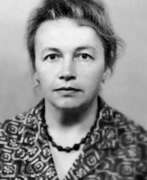

Irina Mikhailovna Baldina (Russian: Ирина Михайловна Балдина) was a Soviet and Russian artist of the second half of the twentieth and early twenty-first centuries. She is known as a painter, a representative of the Leningrad school.
Irina Baldina participated in exhibitions in Leningrad since 1952. Her work covered a variety of genres, including portraits, landscapes, still lifes and genre compositions. From 1960 to 1980, her works were characterized by themes of modernity, nature and people of Zaonezhye. Her style was characterized by broad brushstrokes, decorative and mastery in conveying the colors of northern nature.
Her works are in museums and private collections all over the world, including Russia, France, USA, Japan and other countries.
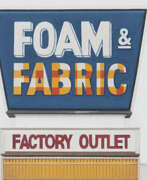

Mike Bayne is a contemporary Canadian artist creates miniature Photorealist paintings of overlooked North American scenes, frequently of his childhood town. Capturing every detail from his working photographs, he replicates his subject not only in terms of imagery, but often also in scale, by mimicking the size of actual commercially printed photographs. His depictions of architecture and vehicles render environments locked in a moment of time, devoid of people and movement. Visually, his works are at once abruptly realistic, and yet purposefully inorganic. He received his MFA from Concordia University and has participated in many group shows across the U.S. and Canada. His work is in the collection of the National Gallery of Canada, the Art Gallery of Ontario, the Nerman Museum etc. Bayne was also the recipient of the Kingston Prize for Portraiture in 2011.
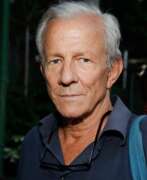

Peter Hill Beard was an American artist, photographer, diarist, and writer who lived and worked in New York City, Montauk and Kenya. His photographs of Africa, African animals and the journals that often integrated his photographs, have been widely shown and published since the 1960s.


Victoria Markovna Belakovskaya (Russian: Виктория Марковна Белаковская) was a Russian Soviet artist of the mid-twentieth century. She is known as a painter, graphic artist and representative of the Leningrad school of painting.
Victoria Belakovskaya participated in exhibitions of Leningrad artists since the early 1930s. Her work covers various genres, including portraits, genre compositions, still lifes and landscapes. Her famous works include "Pioneer Girl" (1931), "Self-Portrait with a Cigarette" (1936), "Leningrad Landscape" (1953), "Spring Flowers. Still Life" (1961), a series of landscapes of Altai, Crimea, Kiev and others.
Works by the artist are in the collections of museums in Russia, Great Britain, USA, France and other countries.
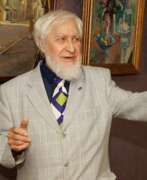

Yuri Vladimirovich Belov (Russian: Юрий Владимирович Белов) was a Soviet and Russian artist of the second half of the twentieth and early twenty-first centuries. He is known as a painter, a representative of the Leningrad school, who worked in the genres of portrait, landscape, still life and historical painting.
Yuri Belov actively participated in exhibitions since 1954. In 1960-1980 the main theme of his work was the images of Lenin and the history of the revolutionary movement. The artist's manner evolved from strict objectivism to a more decorative and impressionistic style.
The master's works are in museums in Russia, France, the USA, Germany and other countries, as well as in private collections.
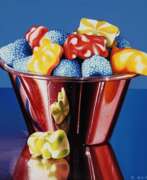

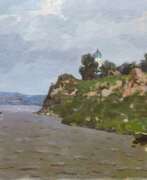

Yakov Tarasovich Besperstov (Russian: Яков Тарасович Бесперстов) was a Russian Soviet artist of the second half of the twentieth century. He is known as a painter, muralist, representative of the Leningrad school of painting.
At the initial stage of his career, Yakov Besperstov worked in the field of monumental and decorative painting, participating in the painting of various buildings. Later he moved to easel painting, creating portraits, genre paintings, as well as urban landscapes. His works were exhibited at exhibitions from the late 1950s and were appreciated by leading artists of Leningrad. The master traveled extensively throughout various regions of Russia and other countries, including France.
His works are in museums and private collections in various countries, including Russia, France, Belgium, Germany, Spain and Italy.
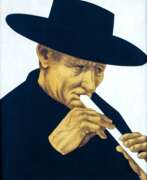

Arne Besser is a contemporary American artist. He received training as an artist at the Art Center School, Los Angeles. There he studied with John Audubon Tyler and Lorser Feidelsson. Beser’s approach to Photo-Realism is to draw from the urban landscape and nature a succinct “set like” image of reality. His city scenes depict New York street life alive with trading and traders, prostitutes and junkies looking for a fix. These visual images iconify the underside of urban life in a way that elevates this point of view to an almost mythic level.
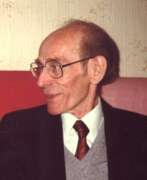

Boris Georgievich Birger (Russian: Борис Георгиевич Биргер) was a Soviet artist of the second half of the twentieth century of Jewish origin. He is known as a portrait painter, a representative of "unofficial art", a follower of symbolism.
Boris Birger developed his individual style of portrait painting, recognizable by his colorism. He often portrayed representatives of the liberal creative intelligentsia and was twice expelled from the Union of Artists of the USSR because of his criticism of official cultural policy.
In the 1970s his work was recognized abroad, especially in Germany, and from 1990 he lived in that country.
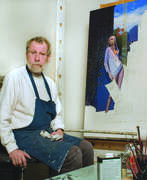

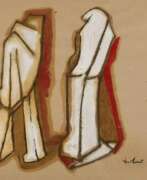

Otmar Blaser is a contemporary German artist. In 1967 he studied at the Werkkunstschule with Prof. Holweck. In 1968 he traveled through Europe, the Middle East, Canada and America. From 1970-1976 he studied at the University of the Arts in Berlin. In 1975 he was a master's student with Professor Bachmann, in 1976 he was an assistant to Professor Kapitsky at the Institute of Visual Communication and Design. In 1977 he was a lecturer at the Volkshochschule Berlin-Neukölln, collaborating freelance with the Theatertreffen Berlin.
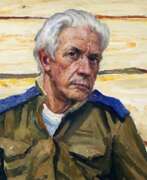

Mikhail Grigorievich Bogatyryov (Russian: Михаил Григорьевич Богатырёв) was a Soviet and Russian artist of the second half of the twentieth century. He is known as a painter.
Mikhail Bogatyryov participated in the Great Patriotic War, was wounded and became disabled. His work focused on the theme of war and the life of rural toilers. He also created works in the genres of still life and landscape. His paintings are in museum collections, including Russian regional art galleries, as well as private collections in Russia and abroad, including countries such as France, Japan, Germany and Italy.


Olga Borisovna Bogayevskaya (Russian: Ольга Борисовна Богаевская) was a Soviet and Russian artist of the second half of the twentieth century. She is known as a painter, graphic artist, teacher, and representative of the Leningrad school.
At the beginning of her career, Olga Bogayevskaya taught painting at the Secondary Art School of the Leningrad Institute of Painting, Sculpture and Architecture and participated in exhibitions. Her works, notable for their uncommon colorism, included children's portraits, interior and exterior still lifes. In 1950-1960 she was already considered one of the leading artists of Leningrad.
Her works are in many museums and private collections around the world, including the State Russian Museum and the State Tretyakov Gallery. Bogayevskaya also exhibited successfully abroad, including France.
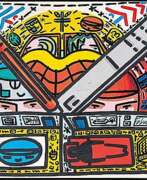

Francois Boisrond is a contemporary French painter. He studied from 1977 to 1980 at the National School of decorative Arts. In 1981 he became involved in the Free Figuration movement. Inspired by visual products (advertising products, posters, stickers, video games etc.), cartoon characters, and by using acrylic paint, Francois Boisrond’s works are colourful, figurative and enigmatic, and his simplified shapes are often outlined in black. He portrays mainly characters, frequently symbolic in everyday situations, but he also depicts urban, maritime or rural landscapes. Besides this Boisrond creates humanitarian and publicity posters. Since the 1990’s the artist has become interested in an imaginary public and the everyday life that invades each and every one of us.
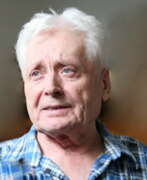

Vasily Pavlovich Borisenkov (Russian: Василий Павлович Борисенков) was a Soviet and Russian artist of the second half of the twentieth and early twenty-first centuries. He is known as a painter and teacher, a representative of the Leningrad school of painting.
Vasily Borisenkov actively participated in Leningrad art exhibitions since 1954, was the author of genre and battle paintings, landscapes and portraits. Among his famous works are the paintings "Difficult Conversation", "Spring", "Strelna. The Beginning of Summer" and many others. The master's works are in museums and private collections both in Russia and abroad.


Nikolay Stepanovich Borovsky (Russian: Николай Степанович Боровский) was a Soviet Ukrainian artist of the second half of the twentieth century. He is known as a painter and teacher.
Nikolay Borovsky became famous for his portraits, landscapes and still lifes, as well as genre paintings. Some of his works were characterized by extraordinary realism. Since the early 1960s, he actively exhibited his works and in 1964 joined the Union of Artists of the USSR. For his painting "Worker. Year 1928" he received the prize of the Union of Artists of the Ukrainian SSR.
The master created a significant number of works that are in private and public collections, including a gallery of portraits of participants in the defense and liberation of Dnepropetrovsk.


Jason Brooks is a contemporary British artist known for his fashion illustrations and portraits. He was born in 1969 and studied at Chelsea School of Art and Central Saint Martins in London. His work has been published in publications such as Vogue, Elle and The New Yorker.
Jason Brooks has worked with fashion brands including Chanel, L'Oreal and Christian Dior. As well as commercial work, he has exhibited his work in galleries around the world, including the Saatchi Gallery in London and the Museum of Modern Art in Tokyo.
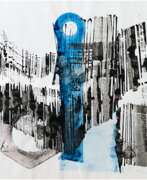



James Brown was an American-born painter active in Paris and Oaxaca, Mexico. He was most well known in the 1980s for his rough painterly semi-figurative paintings, bearing affinities to Jean-Michel Basquiat and East Village painting of the time, but with influences from primitive art and classical Western modernism. His work has taken on several styles over the years but maintains a hand-made look combining concerns of the modernist tradition with motifs and spiritual interests from tribal art. Much of his work is a non-realistic but contains depictions or signs of recognizable faces or objects. However, the line between representation and abstraction is often a difficult one in his work. Besides paintings Brown has also produced sculptures and series of prints at various points in his career, and in the 1990s started to heavily utilize collage.
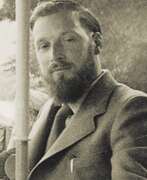

Lionel Victor Bulmer was an English impressionist painter, a member of the New English Art Club, founded in 1886 as an exhibition society dedicated to promoting the avant-garde technique of French impressionist painting, the influence of which was clearly evident in Bulmer's own work.
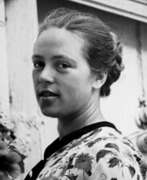

Zlata Nikolaevna Byzova (Russian: Злата Николаевна Бызова) was a Soviet and Russian artist of the second half of the twentieth and early twenty-first centuries. She is known as a painter, a representative of the Leningrad school, famous for her genre compositions, portraits, landscapes and studies from life.
Zlata Byzova achieved particular success in provincial portrait-types and Old Ladoga sketches of the 1960s-1970s. Her works were successfully presented at exhibitions and auctions of Russian painting in France in 1989-1992.
The artist's works are in museums and private collections in Russia, Finland, Germany, France and other countries.


Harry Callahan was an American photographer and artist who is best known for his innovative and experimental work in the mid-20th century. He was began his artistic career as a painter before turning to photography.
Callahan's photographic work was characterized by his interest in abstraction, pattern, and form. He often photographed everyday objects and scenes, such as street signs, buildings, and landscapes, and used his camera to explore the beauty and complexity of the world around him.
Callahan was also known for his work as a teacher, and he taught photography at the Rhode Island School of Design for many years. His students included notable photographers such as Aaron Siskind and Ray K. Metzker, and he was known for his rigorous and challenging approach to teaching.
Callahan's legacy as an artist and photographer continues to influence contemporary photography and art. His innovative techniques and distinctive style continue to inspire new generations of artists, and his work is recognized as a significant contribution to the history of photography.
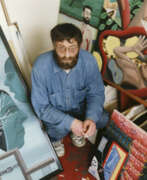

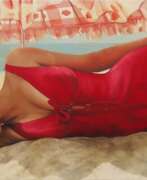

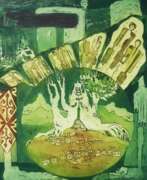

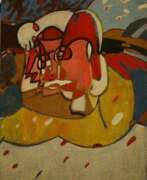

Pierre Courtens is a French painter of Belgian origin. In 1942 he entered the Academy of Fine Arts of Saint-Josse-ten-Noode, having as a teacher the painter Jacques Maes. He also studied monumental decorative art at Anto-Carte, took courses at the Higher Academy of the Kingdom of Belgium in Antwerp in etchings and woodcuts (Cours Broccas). He is particularly famous for the portraits he made of Antonin Artaud, whom he met in 1946.
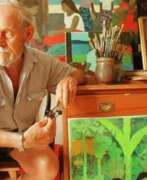

Ray Austin Crooke was an Australian artist known for for serene views of Islander people and ocean landscapes, many of which are based on the art of Paul Gauguin. He won the Archibald Prize in 1969 with a portrait of George Johnston. His painting The Offering (1971) is in the Vatican Museum collection. Many of his works are in Australian galleries. He was made a Member of the Order of Australia in the 1993 Australia Day Honours, "in recognition of service to the arts, particularly as a landscape artist".
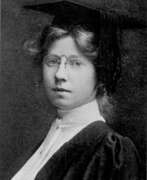

Imogen Cunningham was an American photographer known for her botanical photography, nudes, and industrial landscapes. Cunningham was a member of the California-based Group f/64, known for its dedication to the sharp-focus rendition of simple subjects.
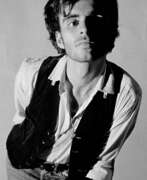

Ronnie Cutrone was an American pop artist known for his large-scale paintings of some of America's favorite cartoon characters, such as Felix the Cat, Pink Panther and Woody Woodpecker. Cutrone's paintings are colorful, lively, and less challenging than those of his contemporaries. As Andy Warhol's assistant at the Factory atop the Decker Building from 1972 until 1980, Cutrone worked with Warhol on paintings, prints, films, and other concepts, eventually co-opting Warhol's earliest work (pre-1960) as well as works by Roy Lichtenstein and others, until finally distilling those myriad influences into the style a few critics eventually labeled "Post-Pop". Together with Kenny Scharf, Cutrone revived the comic strip in painting. By using established comic characters such as Woody Woodpecker and Felix the Cat, Cutrone rephrased themes of originality and authorship, and of low-brow taste and fine art which makes him directly indebted to Pop Art of early Sixties.
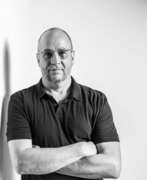

Philip-Lorca diCorcia is an American photographer and artist. He is known for his staged and cinematic photographs that often blur the line between reality and fiction.
DiCorcia's work is characterized by his use of elaborate sets and lighting, which he uses to create images that are both beautiful and unsettling. Many of his photographs feature everyday people in staged settings, and he often uses strangers as his subjects, adding to the sense of mystery and voyeurism in his work.
DiCorcia has been the recipient of numerous awards and his work has been exhibited in galleries and museums around the world. He has also been commissioned to create photographs for a wide range of clients, including fashion magazines and advertising campaigns.
DiCorcia's legacy as an artist and photographer continues to influence new generations of artists. His innovative techniques and approach to photography have helped to redefine the medium and have had a significant impact on contemporary art and culture.
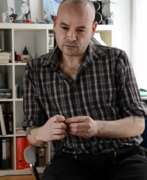

Georg Dinz is a contemporary Austrian artist. After studying at the Vienna University of Applied Arts, Dienz lives and works as a room and stage designer in the Viennese punk scene. Shortly after the fall of the Wall, Dienz moves to Berlin, where he takes part in various art projects in the wild post-reunification period. Today he concentrates on free painting in his studio in the former Berlin artist district of Prenzlauer Berg. Georg Dienz's works are stylistically characterized by a flat and clear application of paint and can be described as "reduced realism".
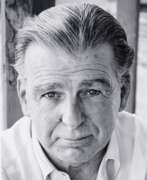

Sir William Dobell was an Australian portrait and landscape artist of the 20th century. Dobell won the Archibald Prize, Australia's premier award for portrait artists on three occasions. The Dobell Prize is named in his honour.
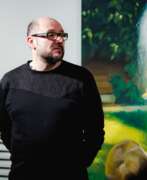

Vladimir Efimovich Dubosarskii (russian: Владимир Ефимович Дубосарский) is a Russian artist. From 1994 to 2014 he worked in an art duo with Aleksandr Vinogradov (russian: Александр Виноградов).
He studied at the Moscow Art College in memory of 1905, then at the Moscow State Art Institute named after V. I. Surikov. Since 1994, a member of the MOSKh, corresponding member of the Russian Academy of Arts.
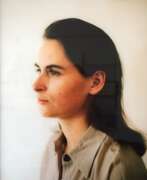

Jeanne Dunning is an American photographer whose work is centered around corporeality and human physicality in abstract forms. Dunning earned her Bachelor of Arts from Oberlin College and her Masters of Fine Arts from The School of the Art Institute of Chicago. From there, she opened her first exhibit at the Feature Gallery in Chicago in 1987. In the early 1990s, Dunning created a series of photographs for an exhibit titled "Directions" which was meant to blur the lines of fact and fiction.The exhibit was displayed at the Hirshhorn Museum in Washington. Dunning's work is included in the permanent collections of the Art Institute of Chicago, the Whitney Museum of American Art, the Museum of Contemporary Art, Chicago, the Museum of Contemporary Photography and the Museum of Modern Art, New York.
